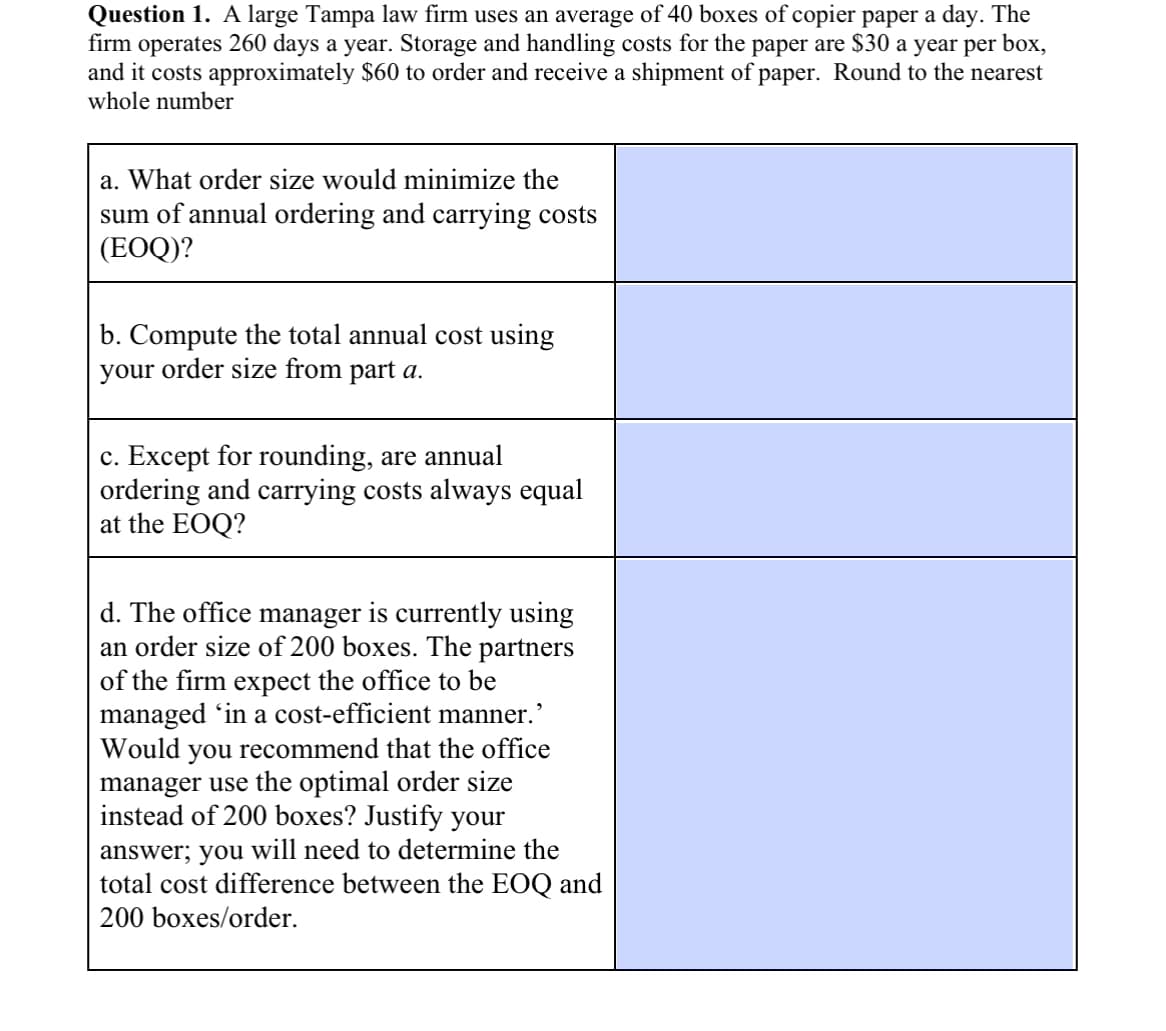Question 1. A large Tampa law firm uses an average of 40 boxes of copier paper a day. The firm operates 260 days a year. Storage and handling costs for the paper are $30 a year per box, and it costs approximately $60 to order and receive a shipment of paper. Round to the nearest whole number a. What order size would minimize the sum of annual ordering and carrying costs (EOQ)? b. Compute the total annual cost using your order size from part a. c. Except for rounding, are annual ordering and carrying costs always equal at the EOQ? d. The office manager is currently using an order size of 200 boxes. The partners of the firm expect the office to be managed 'in a cost-efficient manner.' Would you recommend that the office manager use the optimal order size instead of 200 boxes? Justify your answer; you will need to determine the total cost difference between the EOQ and 200 boxes/order.
Question 1. A large Tampa law firm uses an average of 40 boxes of copier paper a day. The firm operates 260 days a year. Storage and handling costs for the paper are $30 a year per box, and it costs approximately $60 to order and receive a shipment of paper. Round to the nearest whole number a. What order size would minimize the sum of annual ordering and carrying costs (EOQ)? b. Compute the total annual cost using your order size from part a. c. Except for rounding, are annual ordering and carrying costs always equal at the EOQ? d. The office manager is currently using an order size of 200 boxes. The partners of the firm expect the office to be managed 'in a cost-efficient manner.' Would you recommend that the office manager use the optimal order size instead of 200 boxes? Justify your answer; you will need to determine the total cost difference between the EOQ and 200 boxes/order.
Practical Management Science
6th Edition
ISBN:9781337406659
Author:WINSTON, Wayne L.
Publisher:WINSTON, Wayne L.
Chapter2: Introduction To Spreadsheet Modeling
Section: Chapter Questions
Problem 20P: Julie James is opening a lemonade stand. She believes the fixed cost per week of running the stand...
Related questions
Question
Question 1

Transcribed Image Text:Question 1. A large Tampa law firm uses an average of 40 boxes of copier paper a day. The
firm operates 260 days a year. Storage and handling costs for the paper are $30 a year per box,
and it costs approximately $60 to order and receive a shipment of paper. Round to the nearest
whole number
a. What order size would minimize the
sum of annual ordering and carrying costs
(EOQ)?
b. Compute the total annual cost using
your order size from part a.
c. Except for rounding, are annual
ordering and carrying costs always equal
at the EOQ?
d. The office manager is currently using
an order size of 200 boxes. The partners
of the firm expect the office to be
managed 'in a cost-efficient manner.'
Would you recommend that the office
manager use the optimal order size
instead of 200 boxes? Justify your
answer; you will need to determine the
total cost difference between the EOQ and
200 boxes/order.

Transcribed Image Text:Question 2. A company is about to begin production of a new product. The manager of the
department that produces one of the components for the product wants to know how often the
machine used to produce the item will be available for other work.
The machine will produce the item at a rate of 200 units a day. Eighty units are used daily in
assembling the final product. Assembly takes place five days a week, 50 weeks a year. The
manager estimates that it will take almost a full day to get the machine ready for a production
run, at a cost of $300. Inventory holding costs will be $10 per unit. Round to the nearest whole
number
a. What run quantity will minimize total
annual costs (EPQ)?
b. What is the length of a production run
in days?
c. During production, how many units a
day go to inventory as opposed to into
production?
d. What is the cycle time for optimal run
time?
Expert Solution
This question has been solved!
Explore an expertly crafted, step-by-step solution for a thorough understanding of key concepts.
This is a popular solution!
Trending now
This is a popular solution!
Step by step
Solved in 3 steps with 3 images

Recommended textbooks for you

Practical Management Science
Operations Management
ISBN:
9781337406659
Author:
WINSTON, Wayne L.
Publisher:
Cengage,

Operations Management
Operations Management
ISBN:
9781259667473
Author:
William J Stevenson
Publisher:
McGraw-Hill Education

Operations and Supply Chain Management (Mcgraw-hi…
Operations Management
ISBN:
9781259666100
Author:
F. Robert Jacobs, Richard B Chase
Publisher:
McGraw-Hill Education

Practical Management Science
Operations Management
ISBN:
9781337406659
Author:
WINSTON, Wayne L.
Publisher:
Cengage,

Operations Management
Operations Management
ISBN:
9781259667473
Author:
William J Stevenson
Publisher:
McGraw-Hill Education

Operations and Supply Chain Management (Mcgraw-hi…
Operations Management
ISBN:
9781259666100
Author:
F. Robert Jacobs, Richard B Chase
Publisher:
McGraw-Hill Education


Purchasing and Supply Chain Management
Operations Management
ISBN:
9781285869681
Author:
Robert M. Monczka, Robert B. Handfield, Larry C. Giunipero, James L. Patterson
Publisher:
Cengage Learning

Production and Operations Analysis, Seventh Editi…
Operations Management
ISBN:
9781478623069
Author:
Steven Nahmias, Tava Lennon Olsen
Publisher:
Waveland Press, Inc.